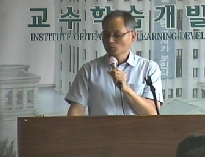The paper starts with an introduction on the definition of the term contradictory structures, its types and its relation to a specific level of poetic consciousness. It also shows the place of contradictory structures during different historical perio...
http://chineseinput.net/에서 pinyin(병음)방식으로 중국어를 변환할 수 있습니다.
변환된 중국어를 복사하여 사용하시면 됩니다.
- 中文 을 입력하시려면 zhongwen을 입력하시고 space를누르시면됩니다.
- 北京 을 입력하시려면 beijing을 입력하시고 space를 누르시면 됩니다.
https://www.riss.kr/link?id=A101954111
- 저자
- 발행기관
- 학술지명
- 권호사항
-
발행연도
2015
-
작성언어
-
- 주제어
-
KDC
790
-
등재정보
KCI등재
-
자료형태
학술저널
-
수록면
107-146(40쪽)
- 제공처
-
0
상세조회 -
0
다운로드
부가정보
다국어 초록 (Multilingual Abstract)
The paper starts with an introduction on the definition of the term contradictory structures, its types and its relation to a specific level of poetic consciousness. It also shows the place of contradictory structures during different historical periods of the discourse of Arabic poetry in which ancient Arabic critics did not pay attention to contradictory structures either for its vagueness, as the critic's mechanisms of analysis were inadequate, or he avoided it. Modern Arabic critics are paid some sort of attention where they examined poetic contradictory structures or the styles of artistic structures of discourse in general. Here lies the significance of this paper since it aims specifically at dealing with contradictory structures in Arabic poetry. This paper examines contradictory structures from different yet integrated aspects. I will begin by studying it as a structure which surpasses the traditional linguistic structures (deviation), and as a structure practicing a technique of concealment and disclosure i.e. a disclosure of linguistic elements in its surface structure and a concealment of other elements which are presented to understand the meaning of contradictory structures according to certain contexts and the recipient's experience. Finally, the researcher studies the aesthetic function/functions of the contradictory structures in text and discourse. In conclusion, the paper confirms that if all types of the poetic contradictory structures are considered ones of the high techniques used in poetic styles in achieving artistic communication between the text and its recipient due to the tension they cause in the poetic discourse, contradictory structures are the uppermost of these types because it increases the level of tension in poetry to a maximum. A contradictory structure is not a result of spontaneous flow of nature, but it is often a rise of consciousness and a method of vision in an attempt to disclose the spiritual and philosophical meaning of phenomena, to express a sense of alienation of reality as being sarcastic showing its contradictions in order to cause a revolution against it. The researcher concludes that that contradictory structures have been used more by modern poets in comparison to ancient or traditional poets. In the ancient poetry, contradictory structures are found more in the poets who were interested in the cognitive function of poetry and benefited from philosophy, for example Abu Nuwas, Abu Tammam, Al-Mutanabbi, Al-Ma'arri, and Sufi poets.
동일학술지(권/호) 다른 논문
-
- 한국아랍어아랍문학회
- 정규영 ( Kyu Young Jung )
- 2015
- KCI등재
-
Grammatical Disagreement: A Historical approach
- 한국아랍어아랍문학회
- ( Najjar Afnan )
- 2015
- KCI등재
-
The Acquisition of Arabic Language and Teaching it to Korean Learners
- 한국아랍어아랍문학회
- 한국아랍어아랍문학회
- 2015
- KCI등재
-
Contradictory structures in Arabic Poetry: Structure and Effect
- 한국아랍어아랍문학회
- 한국아랍어아랍문학회
- 2015
- KCI등재





 스콜라
스콜라



